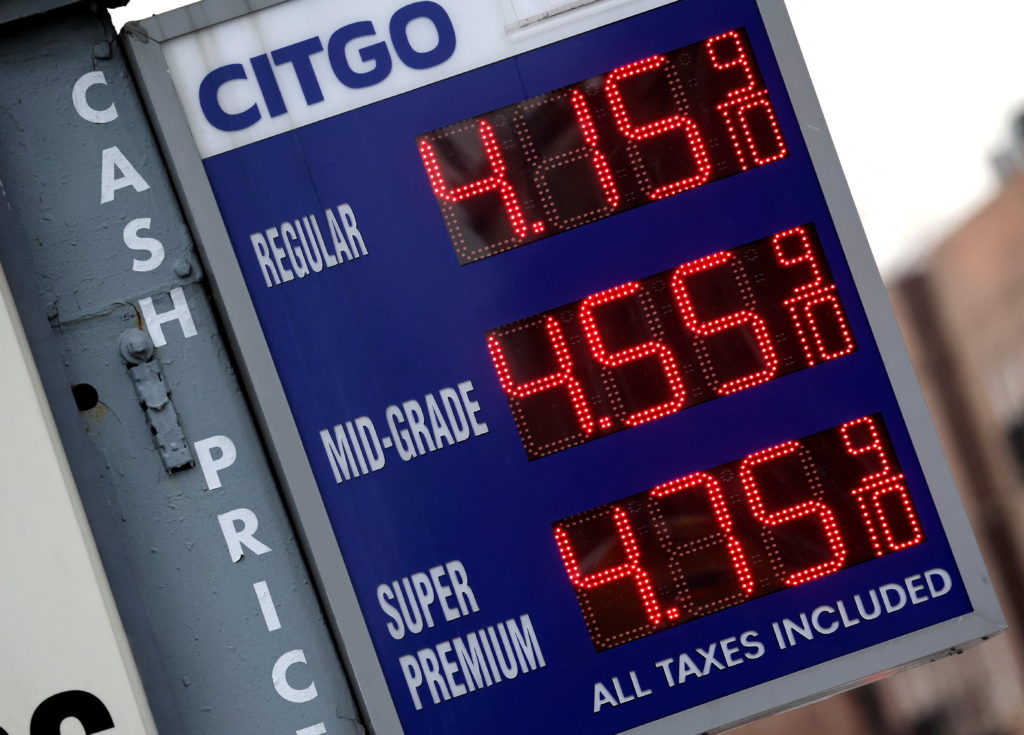
US gas prices have hit an all-time high amid Russia’s invasion of Ukraine.
American motorists are now paying an average of $4.173 a gallon when they fill up, according to AAA, previously known as the American Automobile Association.
The previous record, $4.10 a gallon, was set in July 2008 – adjusted for inflation that would be around $5.37 in 2022 prices.
AAA data shows that gas prices increased 10 cents in one day and 55 cents compared to last week.
Gas prices have increased as the Russian invasion of Ukraine continues, with President Joe Biden set to announce a US ban on Russian oil imports on Tuesday.
The rising gas prices come amid an increase in the price of crude oil, with the price of international benchmark Brent crude costing $128.99 a barrel on Tuesday – an increase of 4.6 per cent over the last month.
In 2020, Russia was in third place on the list of the largest producers of petroleum products in the world, according to the US Energy Information Administration.
Russia is the world’s largest exporter of crude and oil products combined, making up around seven per cent of the global supply, Reuters reported.
International Energy Agency announced the coordinated release of crude oil from 31 member countries last week, such as the US, Canada, South Korea, Mexico and Germany, the AAA said on Monday.
“Consumers can expect the current trend at the pump to continue as long as crude prices climb,” the organisation said.
READ ALSO: Richard Boyd Barrett: Palestinians see double standard as West rallies around Ukraine
“The bigger picture is that supply disruptions are getting worse,” Andrew Lipow, the president of Lipow Oil Associates in Houston, told Reuters. “Nobody wants to touch anything related to Russia.”
According to a report, Average U.S. gas prices rose to an all-time high of $4.104 per gallon Monday, fuel data platform GasBuddy reported, as Russia’s invasion of Ukraine spread chaos throughout energy markets and drove prices up by a record-setting 49.1 cents per gallon over just seven days.
Gas prices are one-tenth of a cent higher than the previous record of $4.103 per gallon in 2008, shortly before the Great Recession, GasBuddy said.
The American Automobile Association reported Monday the national average gas price was $4.065 per gallon, slightly lower than the GasBuddy average and just below AAA’s all-time record of $4.114 per gallon in July 2008.
Average regular gas prices are highest in California ($5.34 per gallon), Hawaii ($4.70), Nevada ($4.59), Oregon ($4.51) and Washington ($4.45), according to AAA data.
Prices for jet fuel and diesel were also affected: National average diesel prices rose to $4.63 per gallon Monday, and are likely to break the current record of $4.846 per gallon within two weeks, according to GasBuddy (AAA says diesel costs $4.614 per gallon).
Average diesel prices Monday hit $5.69 per gallon in California, $5 in Pennsylvania, $4.94 in Hawaii, $4.85 in New York and $4.81 in Oregon, AAA reported.
In the immediate aftermath of Hurricane Katrina in 2005, the national average gas price rose by 49 cents per gallon over seven days, a record beaten by one-tenth of a cent Monday, according to GasBuddy.
The cost of crude oil leapt to $119.75 per barrel Monday, up about 59% year-to-date, after Secretary of State Antony Blinken announced Sunday the U.S. was considering a ban on Russian oil imports, marking a shift from the Biden Administration’s earlier hesitancy to implement such a ban.
The energy sector has largely been excluded from the sanctions imposed on Russia by Western countries in recent weeks, but because Russia depends on fuel revenue for more than a third of its federal budget, sanctions limiting its ability to export oil and gas to the West could have a dramatic impact on Russian President Vladimir Putin’s regime.
Though the U.S. only gets about 3.5% of its oil from Russia, a U.S. ban would have symbolic significance, Rabobank energy analyst Ryan Fitzmaurice told CNN, further signaling Russia’s economic exclusion by much of the world. European Union leaders have debated whether to ban Russian oil—a more-than-symbolic gesture, as the EU relies on Russia for about 27% of its crude oil.
In January, the White House announced it was seeking alternate fuel sources for Europe, anticipating a scenario in which Russian fuel exports would be cut off. The recent spike follows a steady months-long trend of rising oil prices, as demand increases following the Covid-19 pandemic.
WHAT TO WATCH FOR
Elevated prices will likely recover over months rather than weeks as they did in 2008, putting Americans in a “dire situation,” said Patrick De Haan, GasBuddy’s head of petroleum analysis, in a statement. GasBuddy predicted that the mayhem unleashed by Russia’s invasion of Ukraine would be compounded by more typical factors such as increased seasonal demand for gas, possibly driving the national average price to a new all-time high over $4.25 per gallon by Memorial Day.
CRUCIAL QUOTE
“This is a milestone that was hard to imagine happening so quickly, but with bipartisan support of severe sanctions on Russia, is not exactly surprising—it is the cost of choking off Russia from energy revenue,” De Haan said in a statement Friday. “As Russia’s war on Ukraine continues to evolve and we head into a season where gas prices typically increase, Americans should prepare to pay more for gas than they ever have before.”
CONTRA
The Midwest and South Central U.S. were not as severely impacted by rising gas prices. Average regular gas prices Monday hit a relatively moderate $3.63 per gallon in Missouri, $3.65 in Oklahoma, $3.68 in Kansas, $3.69 in Arkansas and $3.70 in South Dakota, AAA reported.












